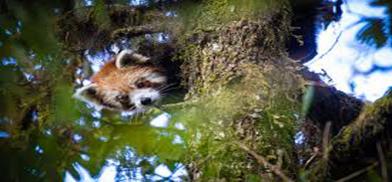Tracking Nepal’s red panda by satellite
Despite the COVID-19 lockdown, conservationists in eastern Nepal are busy tracking ten wild red pandas they had fitted for the first time with GPS-satellite collars in December to monitor their behaviour and habitat

Despite the COVID-19 lockdown, conservationists in eastern Nepal are busy tracking ten wild red pandas they had fitted for the first time with GPS-satellite collars in December to monitor their behaviour and habitat.
The 10 red pandas were tranquilised and fitted with collars in the Panchthar-Ilam-Taplejung (PIT) Corridor, a forested area on the border between Nepal and India near Mt Kangchenjunga, the world’s third-highest mountain.
The data shows the movement of red panda between the Nepal and India, and also allows researchers to track their habits. This will help them protect the shy animal, which is listed as an endangered mammal on the International Union for Conservation of Nature (IUCN) Red List of Threatened Species.
“This is a great milestone in red panda conservation,” says Man Bahadur Khadka, Director General of Nepal’s Department of Forests and Soil Conservation (DOFSC). “We are committed to the protection and conservation of this charismatic species whose survival is mainly threatened by human factors.”
This satellite tracking provides data of the pandas’ positions every two hours, and will help conservationists better understand how red pandas interact in a habitat that is dominated by human settlements. Their movement, interaction with each other and response to disturbances will be analysed, says lead investigator Damber Bista a PhD student at the University of Queensland.
This GPS-Satellite tracking project is led by the DOFSC of with technical support from the Department of National Parks and Red Panda Network. The tracking and collaring of the six female and four male red pandas took three months from September to December 2019 in Sandakpur Rural Municipality of Ilam district.
The research team consisted of officials from the government, Red Panda Network, University of Queensland, local Forest Guardians, and the Divisional Forest Office in Ilam and Janno Weerman at Rotterdam Zoo.
Red panda sightings are regarded as auspicious by local people, and their cuddly appearance make them a popular species. Yet their numbers in Nepal are dwindling because of poaching and habitat destruction. Despite not having any medicinal, cultural, or religious value of red panda, it’s illegal pelt trade in Nepal is on the rise due to the misconception among public.
Known as habre in Nepali and punde kundo in the local dialect in Ilam, the red panda is from a distinct taxonomical group and is not related to the giant panda, which belongs to the bear family.
“Red pandas are the only extant member of their taxonomic family,” explains Angela Glatston of the Global Species Management Plan and chair of the Red Panda Network board, “which means that if they were to become extinct that would be, at least taxonomically, like losing the whole cat family, from lions to domestic cats.”
The animal lives on the canopy of broadleaf and mixed temperate forests from western Nepal right up to Sichuan, and is an excellent tree-climber. There are now less than 10,000 wild red pandas worldwide, and 800 in zoos around the world. There are only 1,000 left in 24 of Nepal 77 districts.
Despite the stiff penalties for killing the animal, they are poached for their hides even though there does not seem to be a trans-boundary market for the fur. While red panda inside Nepal’s national parks are protected, now communities in Nepal’s eastern districts of Panchthar, Ilam and Taplejung which have one-fourth of the total red panda population in the country have set up Forest Guardians to protect and monitor the red panda.
This red panda named Mechhachha was collared in December 2019. Photo: Damber Bista/Red Panda Network
The GPS-satellite collar study is part of the Red Panda Network’s long-term monitoring initiative and is already providing valuable baseline data on the animal’s ecology, distribution, and behaviour. The study is supported by Rotterdam Zoo which has been involved in red panda research and conservation since 1978.
“Data from all ten of the collared animals are being tracked, they seem to be moving about well,” says Sonam Tashi Lama of the Red Panda Network. “If we lose data because of canopy or cloud obstruction we have Forest Guardians on the ground who have VHF antenna and camera traps to go look for them.”
The Network set up the Forest Guardians in villages in the red panda range on the Nepal side of the habitat to provide intelligence about possible poachers and to monitor the animals. Locals in Ilam have not reported any increase in poaching activity during the lockdown, as has been seen in some community forests and national parks in Nepal.
Says Ang Phuri Sherpa Country Director in Nepal of the Red Panda Network: “This is a proud moment for us to have the opportunity to fulfill one of the objectives of Nepal’s Red Panda Conservation Action Plan.”
The red panda range in Nepal, India, Bhutan, Burma and China.
This is the first time GPS-satellite collars are being used to study red pandas in the wild. During the 1980s, the pioneer red panda biologist from Nepal, the late Pralad Yonzon, had used terrestrial radio collars to study red pandas in Langtang National Park, central Nepal. A female red panda among the ten animals collared was named Pralad Devi in honour of the conservationist who was killed when his bicycle was hit by a truck in Kathmandu in 2011.
The other red pandas were named Paaru, Dolma, Chintapu, Mechhachha, Bhumo, Senehang, Ngima, Brian, and Ninamma by local people including Forest Guardians, and the names represent culture, landscape, language, and ethnicity of the region.
The GPS collars were first tested with two captive red pandas at Rotterdam Zoo to evaluate their effectiveness before being fitted on the ten animals in Ilam.
Says Janno Weerman at the Rotterdam Zoo who was involved in collaring the animals in Ilam, says: “It is very important that conservationists on the ground in Nepal and in Rotterdam work together to protect the red panda and their habitat. Part of this cooperation is the GPS collaring research. The results will give us insight into the ecology of the species and their natural habitat.”
https://www.nepalitimes.com/banner/tracking-nepals-red-panda-by-satellite/









Post a Comment